
Central America
Blue Hole, Lighthouse Reef, Belize
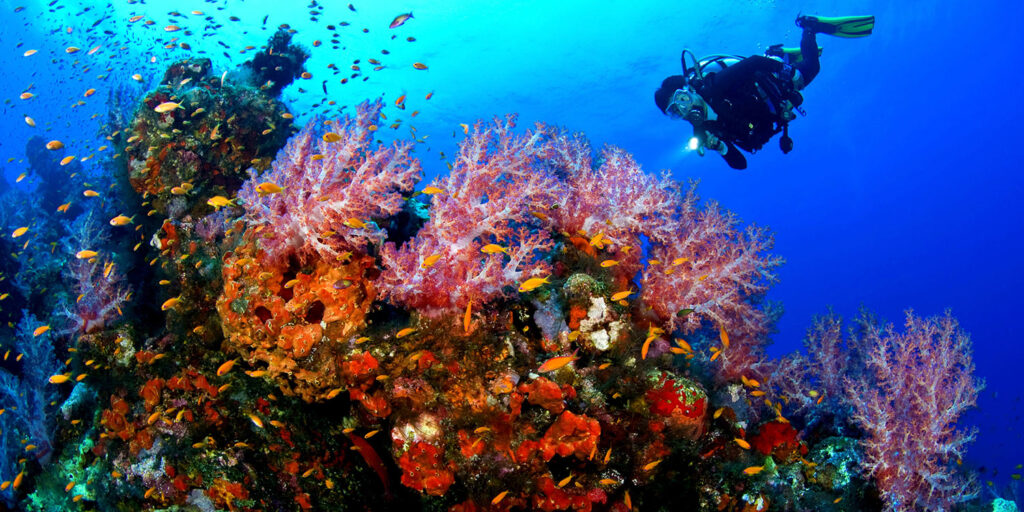
Extreme Level: 9/10
Best time: December – mid-April (water t° – 27 °C/81 °F – 29 °C/84 °F)
Scuba Diving spot is one of the world’s largest sinkholes that filled with Mayan mysteries. The spot is about 300m/984ft across and 125 m/410 ft deep down into the earth.
The world’s largest natural formation. Part of the larger Barrier Reef Reserve System (UNESCO).
There are some dive excursions to the Great Blue Hole are full-day trips (one dive in the Blue Hole and two additional dives in nearby reefs)
After 30m it can be extremely disorientating if you are not an experienced diver. Several divers lost their lives there due to the nitrogen narcosis (depth intoxication/rapture of the deep)
Good news:
- opportunity to dive in crystal-clear waters
- see unique species of marine life – giant groupers, turtles, nurse sharks, reef sharks (Caribbean reef shark and the Blacktip shark)
- eye-catching giant corals and coral formations
Bad news:
- chances to get nitrogen narcosis (depth intoxication/rapture of the deep/“narks”) – effect of anesthetic gas (nitrogen) entering the blood at increased pressure as occurs with deep-sea divers. This will cause serious hazards – change in behaviour brought on by breathing compressed air, consciousness, neuromuscular function
- risk of losing ability to act fast, think rationally, and make good decisions leading to panic and confused state
- presence of sharks
- advanced scuba diving skills are required – Open Water diving certification, comfortable gear, have excellent buoyancy control and be able to equalize easily
- need to dive with experienced divers and follow all the requirements
Depth range | 6m/20ft – 120m/410ft |
AFRICA
Egypt’s Blue Hole, Dahab, and Sinai, Egypt
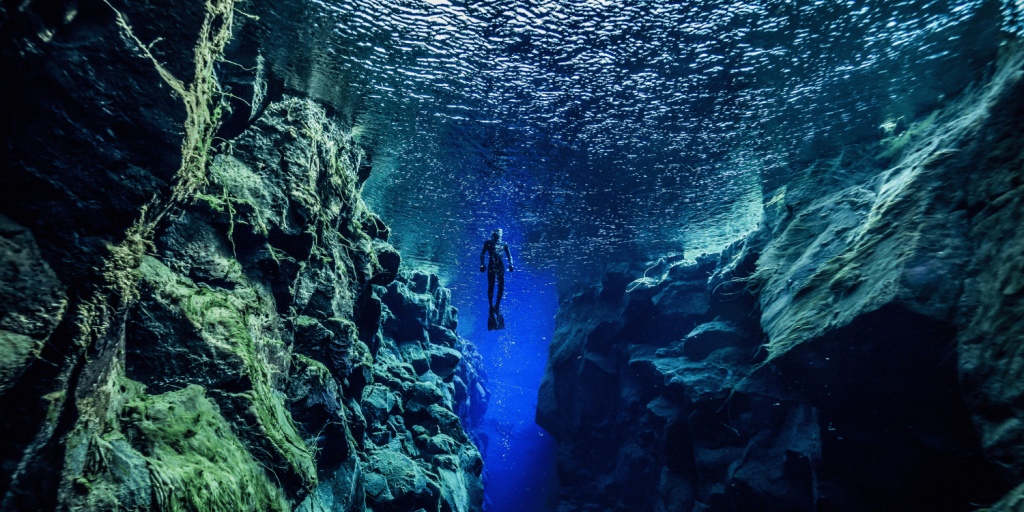
Extreme Level: 10/10
Best time: July – early December (water t°- 25°C/77°F –
28°C/82°F)
Scuba diving site located in Dahab in the Gulf of Aqaba, an arm of the Red Sea that separating Egypt and Saudi This site is considered to be the most dangerous in the world. Its a famous freediving spot for its easy access directly from the shore. `Some even named it as ‘Diver’s Cemetery’…sounds unbelievable and thrilling, isn’t it? This diving site has its distinctive feature – ‘the arch’ or the tunnel 26 meters long as a passageway to open waters which roof is about 56m/184ft tall below the surface (that is over recommended depth – 30m /90ft for any scuba diver) and its bottom reaches to the seaward side reaching about 120m/393ft.
When plunging so deep there is a risk of nitrogen narcosis. High chances to miss ‘the arch’ due to the nitrogen bubbles within the bloodstream and keep descending to the extreme conditions that cause death. For over 15 years roughly between 130 and 200 divers lost their lives in recent years. This is why we had to mark it as 10/10 on our extreme scale.
Have divers cemetery nearby the site for those whose bodies were not found after their death.
Good news:
- expect to swim through crystal clear water and encounter large number of corals and colourful abundant marine life of Red Sea -parrotfish, clownfish, trumpet fish and more…
- the light turquoise water above the corals
- very steep bright pink and yellow coral wall alongside the reef
- depth range: 6m/20ft – 120m/410ft
Bad news:
- chances to get nitrogen narcosis (depth intoxication/rapture of the deep/“narks”) – effect of anesthetic gas (nitrogen) entering the blood at increased pressure as occurs with deep-sea divers. This will cause serious hazards – change in behaviour brought on by breathing compressed air, consciousness, neuromuscular function
- risk of losing ability to act fast, think rationally, and make good decisions leading to panic and confused state
- the most diver fatalities in the world
- advanced diving skills and the highest levels of confidence are required – Open Water diving certification, comfortable gear, have excellent buoyancy control and be able to equalize easily
Depth range | 6m/20ft – 120m/410ft |
GANSBAII, RSA (Republic of South Africa)
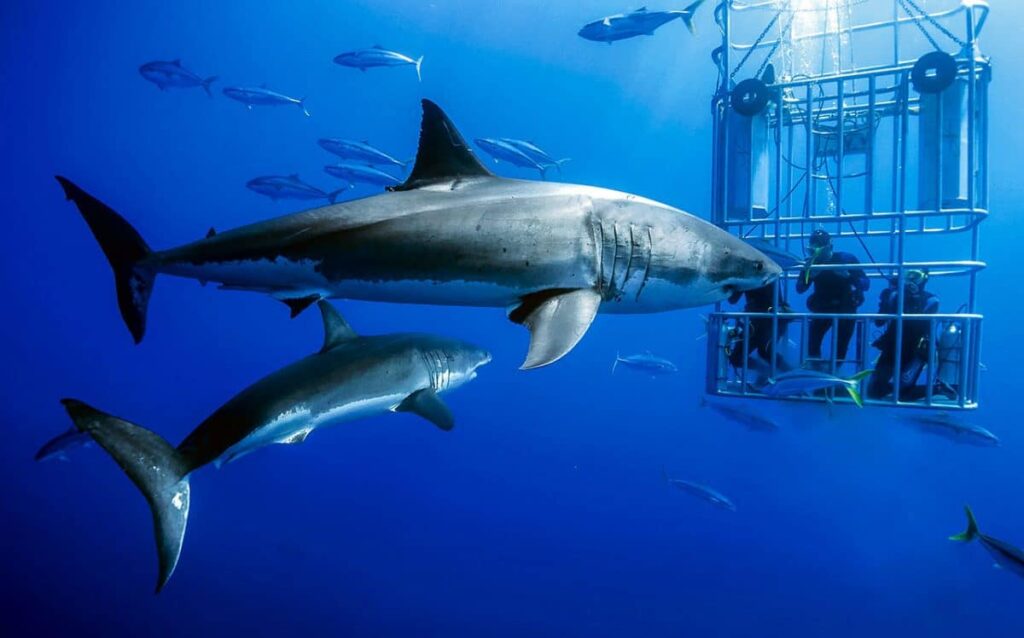
Extreme Level: 7/10
Best time: May – December
White Shark Diving – Fishing town, beautiful Western Cape province in South Africa, at Dyer Island Nature Reserve, which is a territory of Great White shark population and wales watching, supported by local ecotourism.
Also can go to the Klipgat Caves just outside De Kelders in Gansbaii ,which is about 70,000 /80,000 years old, is also unforgeable experience. It is known as the cave where some of the earliest human remains of Homo sapiens that lived in the area from about 2 000 years ago, were uncovered by archaeologists.
Besides, do not miss out on a beautiful sandy beach near the caves!
Oh by the way if you are into hiking, there are various walking trails in Gansbaai, including Platbos Forest, Klipgat, Panorama mountain, and the Fynbos trail. With the guide and without.
Its perfect for family destination. There you can plant a gift tree in the Platbos Forest and name it. This is in favour of tomorrow reforestation project, which is created to protect and restore the forest from the devastating fires. Some trees are older than 1000 years in this Forest..so indeed its not the oldest trees on Earth, the record is fairly belong to the Great Basin Bristlecone Pine (Pinus Longaeva) which is over 5,000 years old (in California, USA), but still this South Africa’s trees are old and impressive!
For family time there is also the Gansbaai tidal pool to cool off as well as snorkel and see some fish. This pool is placed between Gansbaai town and De Kelders, on Kus Weg in Perlemoenbaai,
Good news:
- wildlife spotting (great white sharks and wales)
- shark cage diving to meet the great white sharks face to face (organised and controlled by professionals)
- pristine Pearly Beach – safe and perfect for swimming, ideal for swimming
- long and beautiful hikes, cycling, ideal place for fishing, and other activities for adventure junkie
- family destination – can plant a gift tree in the Platbos Forest and name it; the Gansbaai tidal pool
- not as expensive. The cost varies depending on the season – around $260 – 300 per person in peak season (June – September) and about $190 -200 per person during the low season (December – February)
- during the average season (March – May & October – November) you might see up to 18 sharks
Bad news:
- it is a Great White Shark Capital, which is already frightening to dare
- the cost varies depending on the season – around $260 – 300 per person during the southern hemisphere winter months – peak season (June – September) and about $190 -200 per person during the low season (December – February), average season (March – May & October – November) is also good as you might see up to 18 sharks but prices are similar to the peak-season
Supertubes, Jeffreys Bay, South Africa (Eastern Cape)
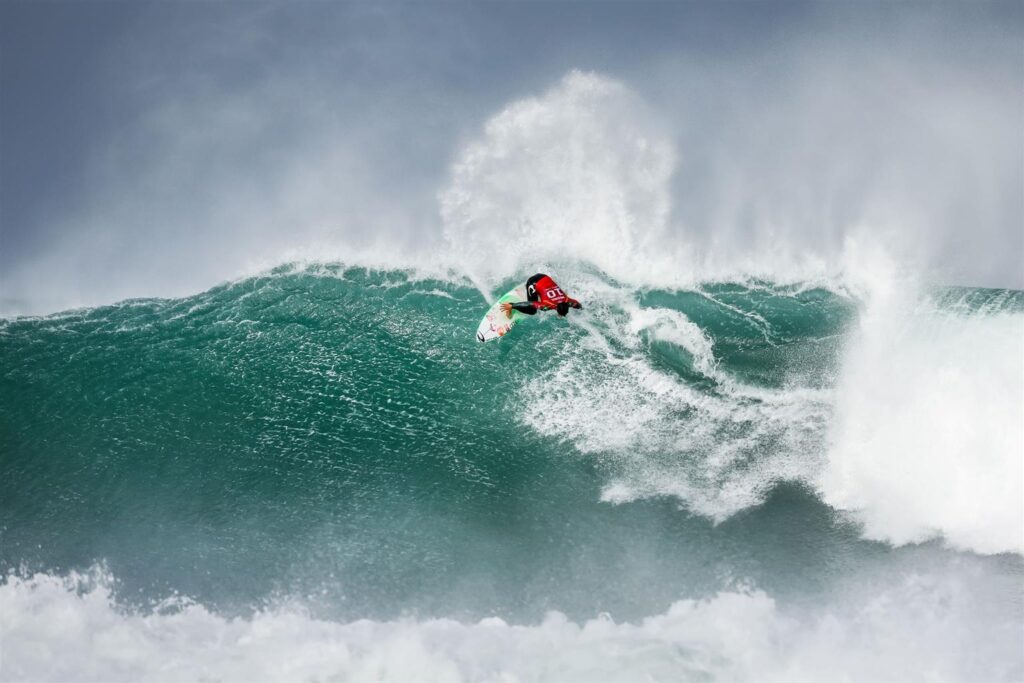
Extreme Level: 7/10
Best time: January – June, August – December
Surfing – Jeffreys Bay town is well-known among the surfers as the surf capital of South Africa for its right-hand point break at Supertubes beach. One of the longest and most exciting right hand breaking waves on Earth. Sitting on the bluffs and looking the art and beauty of surfing the swells all day! Good chances to see few dolphins jumping through the line up.
After all that have been said, of course this place will be crowded. Therefore, local surfers learn how to deal with the boorish behaviour of some tourist surfers who are feeling like a giddy kids with a sugar high every time they get to the beach. If you even one of them this should not stop you since you just need to hold on, wait your turn and show respect. This is just the way to go. If you do so you will earn a reputation for being respectful and you won’t have any problems to catch your wave!
Note that East and South East winds can get crazy in the summer months (December – February) and destroy everything…for real! Look for South West and North West (in the morning) winds that bring fast and high waves —3 m/10 ft to 4 m/13 ft.
The world-famous beach where the Billabong Pro is annually held here in July. By the way after taking the full blast of riding the waves and feeling the vibe of the beach party remember the town is also known for its unique fish, white meet, red meet and salad dishes. What a nice place to cheer you up after rubbing against the board and falling off it for the whole day!
Good news:
- surfing year-round
average warm temperature 32°C/90°F (December – March) and average cold 20°C/69°F (June – August)
- fast and high waves —3 m/10 ft to 4 m/13 ft
- one of the longest and most exciting right hand breaking waves on Earth
- world-famous beach
- the big winter waves comes from the South Indian Ocean in May – August – when the more experienced or professional surfers come
- most beaches are considered safe by international standards
- for intermediate and advanced level of surfing
- low crime and poverty level thanks to good community programs which have improved local life compare to other Eastern Cape districts
Bad news:
- crowded in November – February (high tourist season)
- fewer crimes still have to be aware of
NORTH AMERICA
OAHU (Hawaii), USA
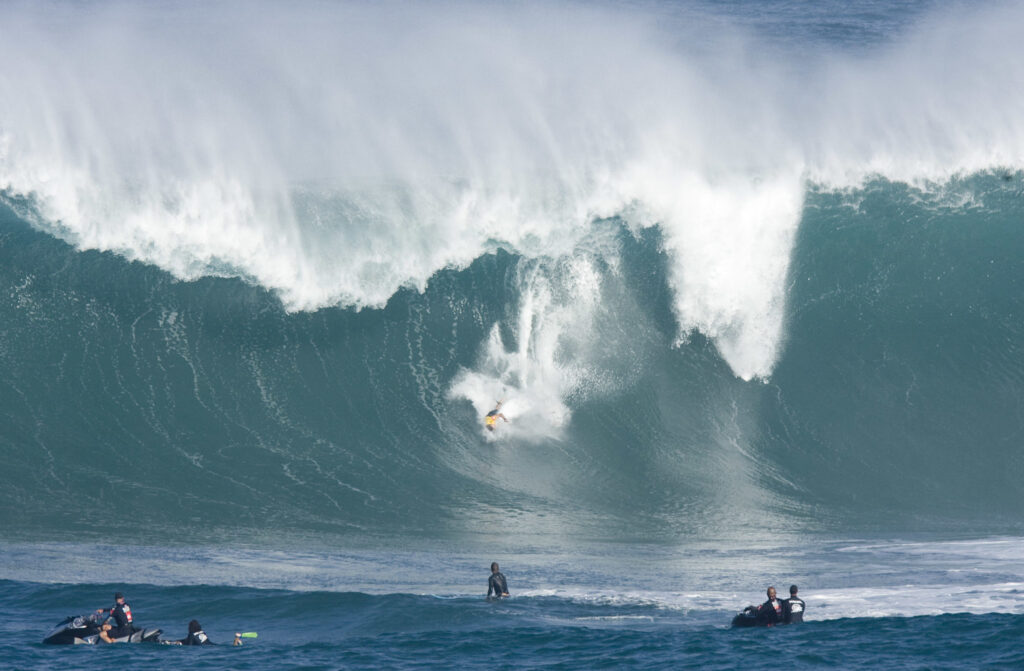
NORTH SHORE OAHU WAVES (Pipeline)
Extreme Level: 9/10
Best time: November – February (big wave surfing)
Surfing – tube the huge waves that break mere yards from the shore over a jagged coral reef in north shore of Oahu. Average heights is about 5 m/17ft (from the top to bottom of a wave’s face). Peak season – waves usually swell to 10-15m /35-50ft and could reach 30m /100ft (November – February)
It is really the winter’s huge surfing waves that coming from the north, you would be terrified to see and dare to slide below the picture perfect crest!
Oahu is said to be the most visited Island of Hawaii. Oahu is gorgeous thanks to its tropical verdure of iconic beaches (Waikiki) a vibrant night scenes, historical background (site of the WWII’s 1941 – Pearl Harbor), home to the USS Arizona Memorial, and inactive volcanoes – Waianae and Koolau. If you would want to see an active Hawaiian volcanoes Mauna Loa (last erupted in 1984), and Kilauea (last erupted in 2018) you would need to go to the main Island of Hawaii (Hawaii Volcanoes National Park is there), which is about 330 km/ 200 mi away, 35-40 minute flight.
But maybe you would rather go to the most beautiful island of Hawaii – Kauai, and see outstanding waterfalls, hiking trails and a variety of eco-adventures. Only about 100 km / 68 mi away from Oahu.
Good news:
- world’s heaviest and deadliest wave, incredibly challenging
- more than 125 beaches
- possibility for tow-in surfing
- big chances of catching and riding a big wave – Average heights is about 5 m/17ft
- peak season – waves usually swell to 10-15m /35-50ft and could reach 30m /100ft (November – February)
Bad news:
- from the early ’60s surfers loosing their lives on that spot
- waves tend to double up upon each other
Middle East
oil themed 'extreme park’, Saudi Arabia
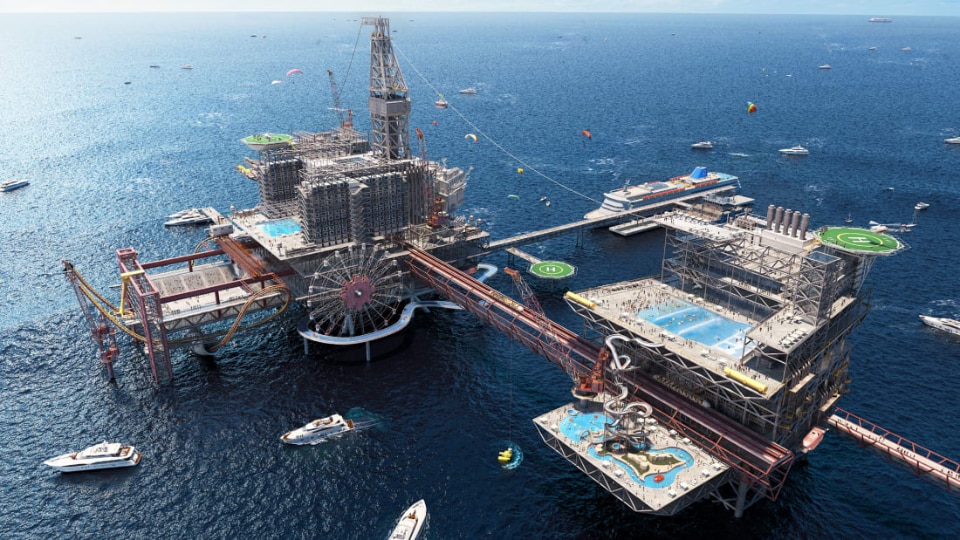
Extreme Level: 7/10
Best time: November – February (December could be most expensive)
Roller coaster, bungee jumping, skydiving – Oil rig as a theme park…Wait, whaaat??? Saudi Arabia go way far to win over other countries to get the trophy of world’s leading tourism destination. One of their creative ideas is using its petroleum industry as inspiration for a brand new tourist attraction! Engineers there love making surprises, we get that.
The plan was announced to convert an oil rig into a “extreme park” and “The Rig” resort in the Arabian Gulf. Apparently, from the news, including CNN travel this all will be about 150,000 square meters.
How cool is that to have roller coaster rides, bungee jumping and skydiving at the same place! 3 hotels with 800 rooms and 11 restaurants are also placed on the connected platforms just right next to the most exciting and thrilling activities.
By the way, “The Rig” resort/extreme park suppose to be accessible by boat, fancy yacht, or even by helicopter…or if you found of swimming but it could take you a while to get there 😉
Good news:
- 3 hotels and 11 restaurants spread over a number of connected platforms
- different adventures and aquatic sporting experiences at the same place
- multiple options of luxury hospitality
- aimed to be the home to the world’s fastest roller coaster when it launches (planned in 2023)
- Funded by Saudi Arabia’s Public Investment Fund (PIF)
- significant value to the local economy of Saudi Arabia
Bad news:
- country’s conservative laws restricting women’s freedoms
- offshore oil platform (which is interesting and exciting at the same time)
- expected to be crowded especially during the peak tourism time (November to February)
- might wait for a certain time to leave the resort – transportation system is unclear
- the cost for such adventure resort is not determined yet
- very high temperatures in summer (38 °C /100°F – 47 °C /117 °F)
OCEANIA
Teahupo'o, Tahiti, French Polynesia
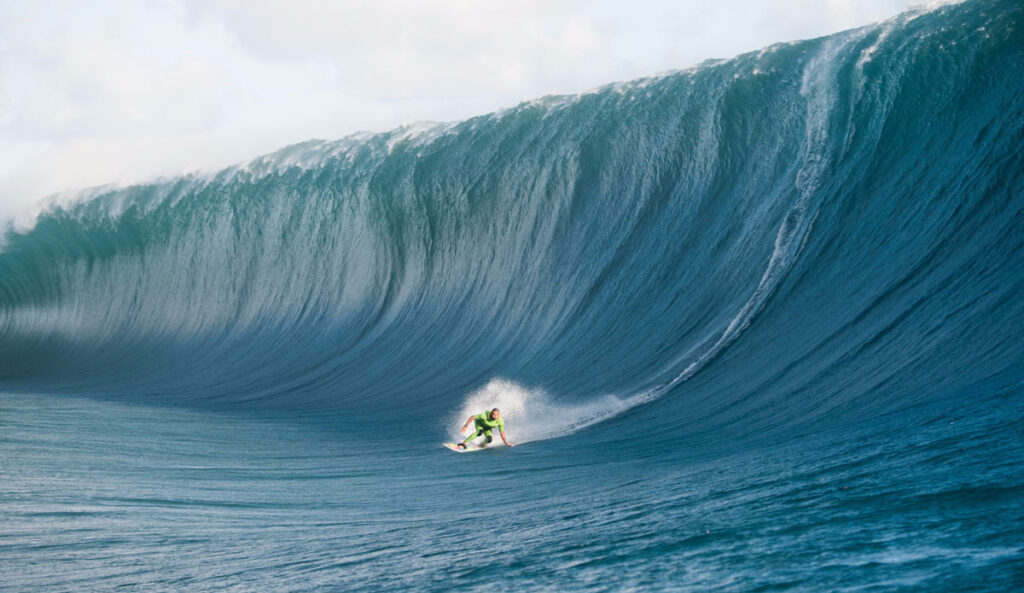
Extreme Level: 10/10
Best time: April – October (big waves), November – March
Surfing – Teahupoʻo is a well-known surfing spot on the southwestern coast of the island of Tahiti, French Polynesia. Basically its a beautiful village placed in the southern part of Pacific Ocean. Teahupo’o having heavy, glassy waves offshore size of about 2 – 3 m/9- 10 ft, and even can get up to 7 m/ 22,9 ft.
In fact this surfing spot often known of having the scariest wave on the Earth. However, due to the magnitude of its dangerous swells only one surfer lost his life on it, in 2000 was slammed in to the reef- local surfer Briece Taerea.
The coral atolls surrounding the entire Island therefore making it more for adrenaline-kicking surf.
Good news:
- well-known surfing spot on the southwestern coast of the island of Tahiti, French Polynesia
- beautiful village
- glassy waves offshore size of about 2 – 3 m/9- 10 ft, and 7 m/ 22,9 ft
Bad news:
- one surfer lost his life
- Island surrounded by razor-sharped reefs
Shipstern Bluff, Tasmania, Australia
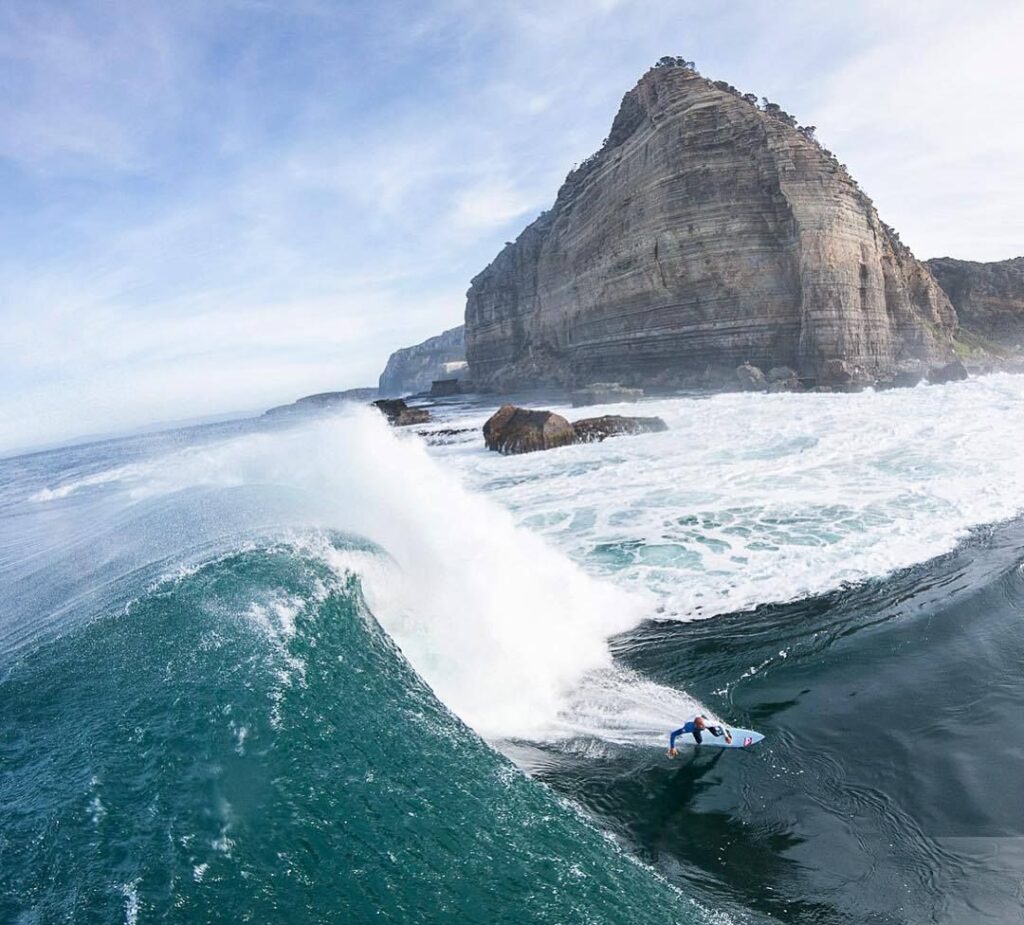
Extreme Level: 9/10
Best time: for big waves – autumn (March to May) and winter (June – August)
Surfing – Shipstern Bluff is a big-wave surfing destination in Tasmania (the southeastern coast).
Fortunately, no surfer ever died at this extreme surfing spot. Number of people suffered from serious injures, including bone fractures, punctured lungs, split skulls and much more…so this waves far from being called easy.
The waves reaching heights of 10 m/ 32 ft. Its massive as you can imagine..but not the biggest, indeed, compare to World Guinness record that was made in 2020 by one daredevil, Portuguese surfer António Laureano, who went ‘all-in’ daring the giant white wave in the shape of enormous wall at Praia do Norte in Nazaré, Portugal (30.9 m/101.4 ft wave).
Shipstern Bluff also has a good walking trail with breathtaking views…The whole walk may take you about 8 km/5 mi in total and while you do so you might as well check out the Tunnel Bay sidetrack signposted.
Good news:
- well-known surfing spot on the southwestern coast of the island of Tahiti, French Polynesia
- for big waves – autumn (March to May) and winter (June – August), December – February peak tourist season
- waves can reach up to about 10 m/ 32 ft
Bad news:
- hiking is fairly long but easy
- weather can change rapidly – need to pack plenty of food, water warm coat against precipitation
- near the coastline there are many drop-offs so need to be careful and support/ supervise children
- its advised that only experienced surfers should test the high waves
- waves can easily get up to 9 m/ 29.5 ft, so be aware!
EUROPE
North Beach (Praia do Norte), Portugal
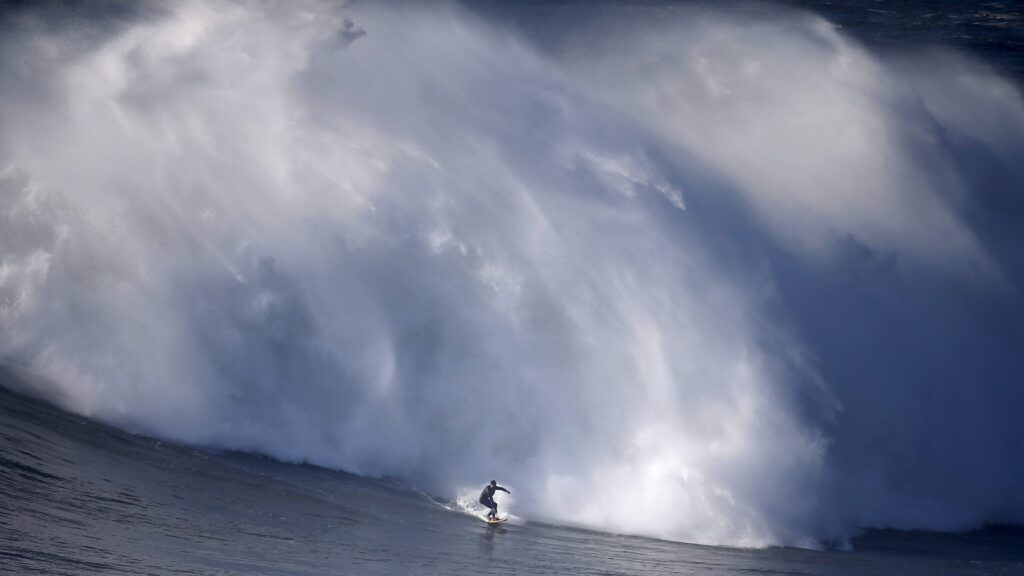
Extreme Level: 10/10
Best time: October – March (big waves – winter season)
Surfing – Praia do Norte is a well-known beach located in Nazaré, Portugal, that accordingly has the biggest waves on Earth, bigger than in Hawaii (Oahu)! These giant white breaking waves were the reason for the Guinness record (Antonio Laureano – 30.9 m/ 101.4 ft) in 2020 for the biggest wave that was ever surfed. This beat the previous Guinness record (2013) of the Hawaiian surfer, Garrett McNamara, who also surfed the wave of 30 m/ 100 ft tall off the coast of Nazaré.
The whole 1.5 km long beach of Praia do Norte is wild, rough and quite dangerous for swimming but if you are a surfer you might appreciate it way more if its rugged and deserted like this one. The Nazaré canyon is the reason behind such big waves formation; the Europe’s biggest underwater ravine – 200 km/124 mi long and a depth that can reach 5,000 m/ 16404.2 ft. Swells also getting big more likely because of its short headwall (less than 1 km/0.6 mi off the coast) that is responsible for anchoring the piping to prevent hydraulic and soil pressures movement as well as ward off soil erosion and scouring from turbulent storm-water.
Good news:
- well-known extreme surfing spot
- claimed both Guinness records for ‘the biggest wave that has been ever surfed’
- Praia do Norte beach is not supervised
- waves can reach up to about 30 m/ 100 ft
- 1.5 km long of golden sand beach
- nobody has died while surfing Nazaré in Portugal
- September and April when big swells start coming in, October through March its a big wave season
Bad news:
- Praia do Norte beach is not supervised (its also could be a GOOD NEWS)
- its advised that only experienced surfers should test the high waves
- waves can easily get up from 10 m/ 32 ft to 30 m /100 ft and more, so be aware!




